
The Ostrogoths were a Roman-era Germanic people. In the 5th century, they followed the Visigoths in creating one of the two great Gothic kingdoms within the Roman Empire, based upon the large Gothic populations who had settled in the Balkans in the 4th century, having crossed the Lower Danube. While the Visigoths had formed under the leadership of Alaric I, the new Ostrogothic political entity which came to rule Italy was formed in the Balkans under the influence of the Amal dynasty, the family of Theodoric the Great.
The 430s decade ran from January 1, 430, to December 31, 439.
The 450s decade ran from January 1, 450, to December 31, 459.

Aetius was a Roman general and statesman of the closing period of the Western Roman Empire. He was a military commander and the most influential man in the Empire for two decades (433–454). He managed policy in regard to the attacks of barbarian federates settled throughout the West. Notably, he mustered a large Roman and allied (foederati) army in the Battle of the Catalaunian Plains, ending a devastating invasion of Gaul by Attila in 451, though the Hun and his subjugated allies still managed to invade Italy the following year, an incursion best remembered for the ruthless Sack of Aquileia and the intercession of Pope Leo I.

Stilicho was a military commander in the Roman army who, for a time, became the most powerful man in the Western Roman Empire. He was of Vandal origins and married to Serena, the niece of emperor Theodosius I. He became guardian for the underage Honorius. After nine years of struggle against barbarian and Roman enemies, political and military disasters finally allowed his enemies in the court of Honorius to remove him from power. His fall culminated in his arrest and execution in 408.
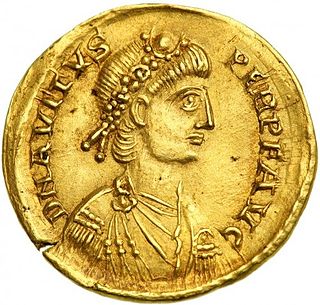
Eparchius Avitus was Roman emperor of the Western Empire from July 455 to October 456. He was a senator of Gallic extraction and a high-ranking officer both in the civil and military administration, as well as Bishop of Piacenza.
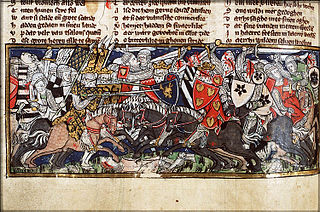
The Battle of the Catalaunian Plains, also called the Battle of the Campus Mauriacus, Battle of Châlons, Battle of Troyes or the Battle of Maurica, took place on June 20, 451 AD, between a coalition – led by the Roman general Flavius Aetius and by the Visigothic king Theodoric I – against the Huns and their vassals – commanded by their king Attila. It proved one of the last major military operations of the Western Roman Empire, although Germanic foederati composed the majority of the coalition army. Whether the battle was of strategic significance is disputed; historians generally agree that the siege of Aurelianum was the decisive moment in the campaign and stopped the Huns' attempt to advance any further into Roman territory or establish vassals in Roman Gaul. However, the Huns successfully looted and pillaged much of Gaul and crippled the military capacity of the Romans and Visigoths. Attila died only two years later, in 453; after the Battle of Nedao in 454, the coalition of the Huns and the incorporated Germanic vassals gradually disintegrated.
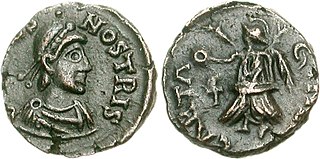
Bonifatius was a Roman general and governor of the diocese of Africa. He campaigned against the Visigoths in Gaul and the Vandals in North Africa. An ally of Galla Placidia, mother and advisor of Valentinian III, Bonifacius engaged in Roman civil wars on her behalf against the generals Felix in 427-429 and Aetius in 432. Although he defeated the latter at the Battle of Rimini, Bonifacius suffered a fatal wound and was succeeded by his son-in-law Sebastianus as patricius of the Western Roman Empire.

This is a chronology of warfare between the Romans and various Germanic peoples. The nature of these wars varied through time between Roman conquest, Germanic uprisings, later Germanic invasions of the Western Roman Empire that started in the late second century BC, and more. The series of conflicts was one factor which led to the ultimate downfall of the Western Roman Empire in particular and ancient Rome in general in 476.
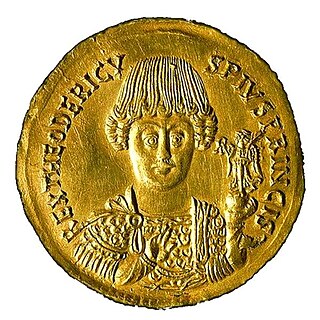
The Ostrogothic Kingdom, officially the Kingdom of Italy, existed under the control of the Germanic Ostrogoths in Italy and neighbouring areas from 493 to 553.
The Gothic Wars were a long series of conflicts between the Goths and the Roman Empire between the years 249 and 554. The main wars are detailed below.
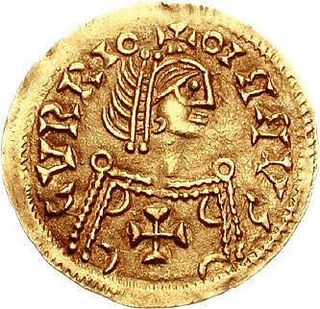
The Visigothic Kingdom, Visigothic Spain or Kingdom of the Goths occupied what is now southwestern France and the Iberian Peninsula from the 5th to the 8th centuries. One of the Germanic successor states to the Western Roman Empire, it was originally created by the settlement of the Visigoths under King Wallia in the province of Gallia Aquitania in southwest Gaul by the Roman government and then extended by conquest over all of Hispania. The Kingdom maintained independence from the Eastern Roman or Byzantine Empire, whose attempts to re-establish Roman authority in Hispania were only partially successful and short-lived.

Theodoric I was the King of the Visigoths from 418 to 451. Theodoric is famous for his part in stopping Attila at the Battle of the Catalaunian Plains in 451, where he was killed.
Flavius Merobaudes was a Roman army officer of Frankish origin. He was appointed magister peditum around 375, and consul twice in 377 and 383. Ancient sources record that he was put to death that year for his support of the imperial usurper Magnus Maximus, but an inscription records that he became consul a third time in 388.
Litorius was a Roman general of the closing period of the Western Roman Empire serving as Magister militum per Gallias mainly in Gaul under magister militum Flavius Aetius. Litorius is noted for being the last Roman commander in the ancient Roman military history to perform pagan rites and the consultation of auspices before a battle.
Gothic revolt of Theodoric I was an uprising of the Gothic Fouderati in Aquitaine during the regime of Emperor Valentinian III (425-455). That rebellion was led by Theodoric I, King of the Visigoths and took place in the South of France. The uprising took place between 425 and 426, in the period shortly after the death of usurpator John and was terminated by a military procedure under the command of Aëtius.
The Burgundian Revolt of Gunther consisted two revolts of the Burgundian foederati in the Western Roman Empire during the reign of Emperor Valentinian III. The uprisings happened in the Gallic province of Germania Prima and was led by the King of the Burgundian Gunther, his main opponent was General Aetius.
The Gothic War (436-439) was a military conflict between the Gothic foederati and the Western Roman Empire of Emperor Valentinian III. This war was fought in the Gallic provinces in the period 436 to 439. The main protagonists in this event were the Gothic leader Theodoric I and the commander-in-chief of the Roman army Aetius. In the contemporaine sources, this conflict is referred to as a war. In addition to this conflict with the Goths, an uprising of the Burgundians and the Bagaudae played in the same period.









